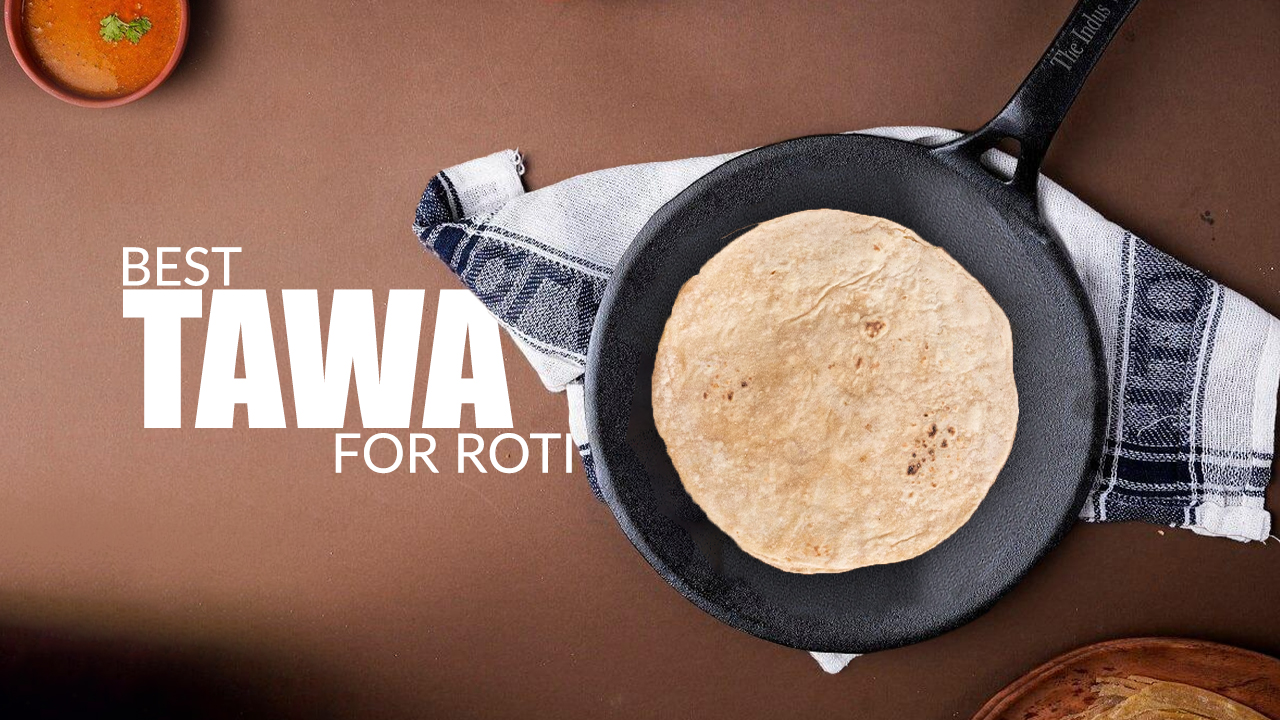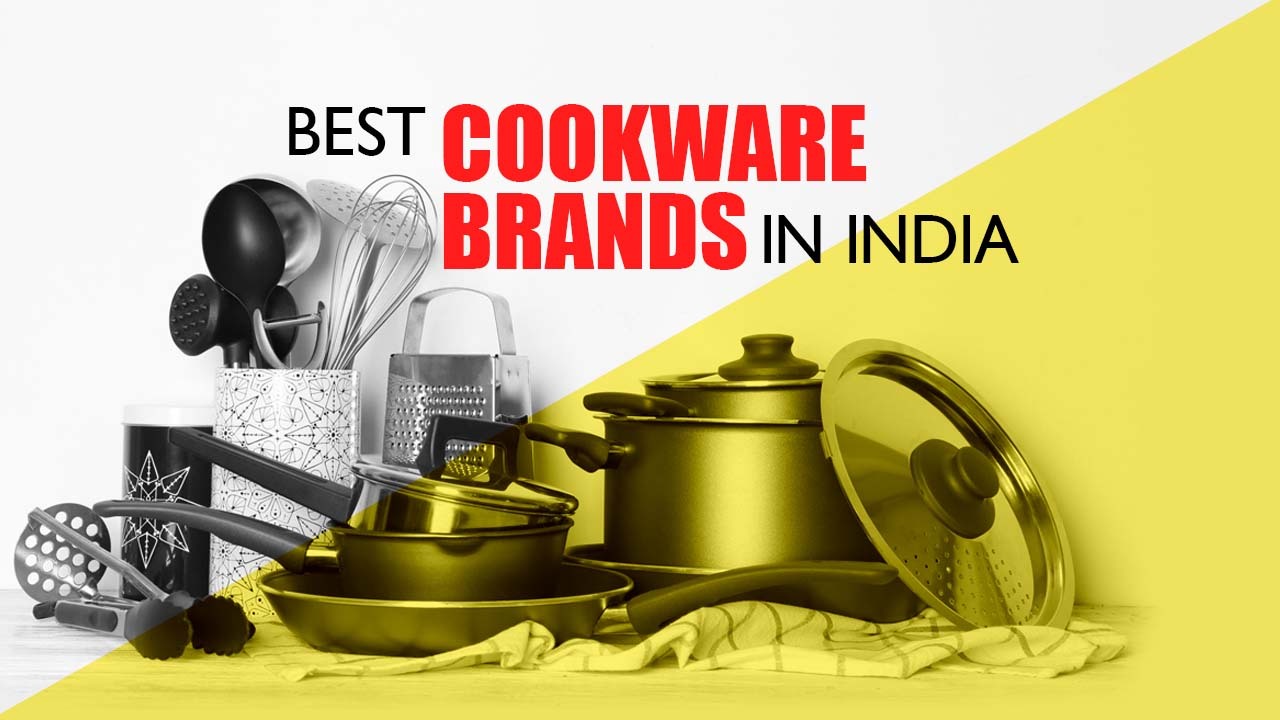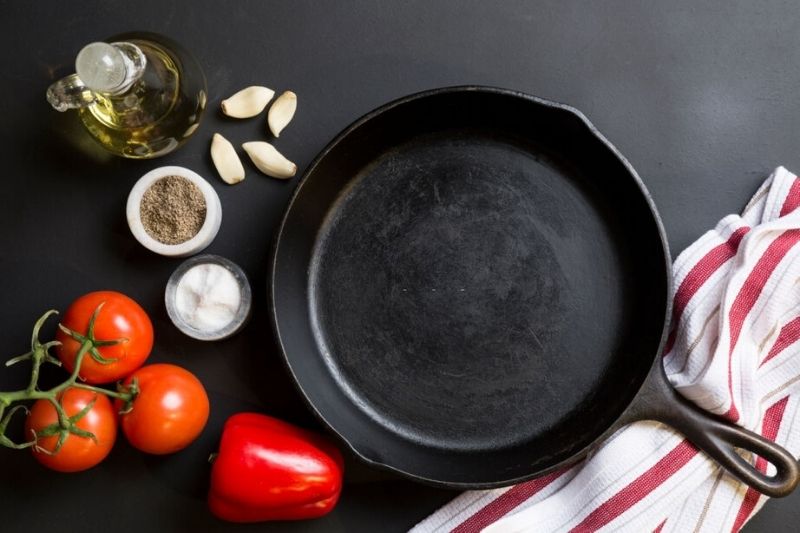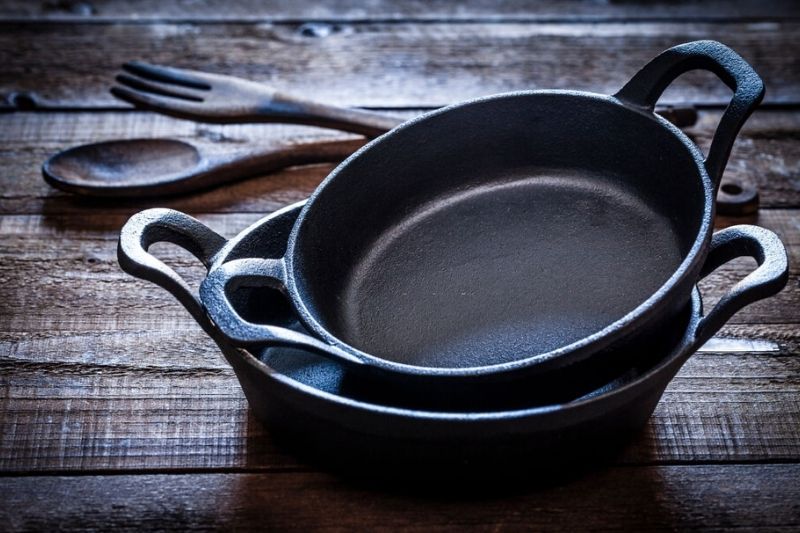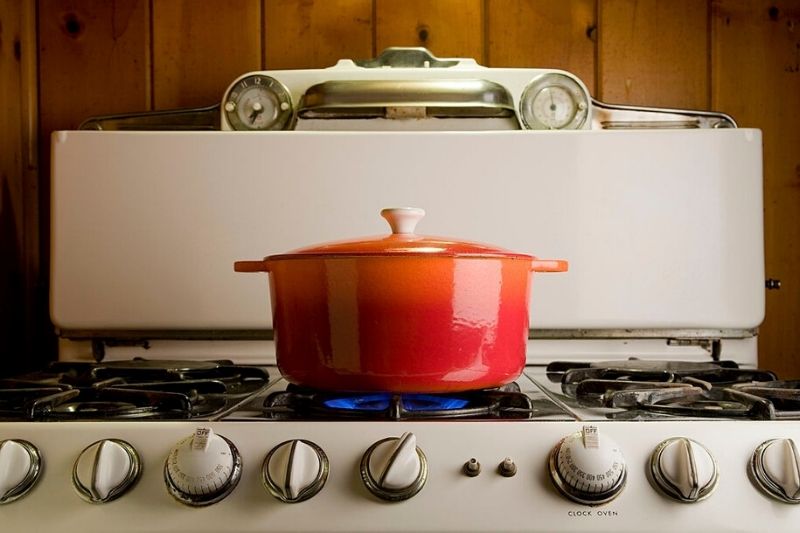All cooks know that many sweet and savory recipes require precise measurements. Sometimes going wrong by even a few grams can lead to disastrous results and make your creations inedible.
The best kitchen scale in India allows you to get a perfect measurement to create real chef specialties without the risk of making trivial mistakes. Not to mention that it eliminates the need to flood your kitchen drawers with tons of measuring cups.
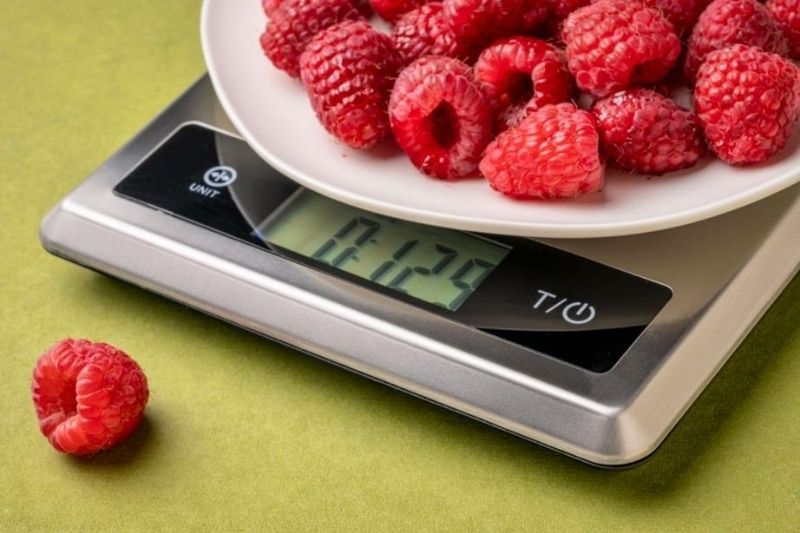
Contrary to popular belief, a kitchen scale is not a tool dedicated exclusively to the zealous pastry chef. It is essential for any type of cooking to accurately measure the right amount of an ingredient.
From calorie counting to weekly meal prep, a reliable brand model is an indispensable tool. And for those on certain diets, an accurate device is a must to properly portion meals.
To choose the model that best suits your needs, you need to make a series of assessments. Only after careful analysis will it be easy to choose the best kitchen scale in India to buy.
Read on to find out everything you should that account to find the best kitchen scale in India for your kitchen. Along the way we’ll also discuss some frequently asked customer questions to clear all your doubts.
List of 10 Best Kitchen Scale In India With Price
Given the wide variety of models available today, choosing the best kitchen scale in India can be difficult. Especially since each machine does not offer the same functions or the same units of measurement. That’s why we analyzed and compared 40 kitchen scales sold in India for nearly 25 hours, and took into account the opinions of 400 consumers.
| S. No. | Best Kitchen Scales | Price |
| 1. | Glun Digital Kitchen Scale | Rs. 359 |
| 2. | Dr Trust (USA) Digital Kitchen Scale | Rs. 599 |
| 3. | Curaze Digital Kitchen Scale | Rs. 989 |
| 4. | MEDITIVE Digital Kitchen Scale | Rs. 1,750 |
| 5. | ATOM Digital Kitchen Scale | Rs. 580 |
| 6. | MCP Digital Kitchen Scale | Rs. 1,299 |
| 7. | Nova Digital Weighing Scale | Rs. 1,749 |
| 8. | Sansui Digital Kitchen Scale | Rs. 1,799 |
| 9. | Bulfyss Digital Kitchen Scale | Rs. 599 |
| 10. | EAGLE Digital Kitchen Scale | Rs. 799 |
📌Check Also: Best Kitchen Knife Set in India
Top 10 Kitchen Scale In India 2021 – Reviewed
- Rylan Digital Kitchen Scale
- Hesley Smart Kitchen Scale
- HealthSense KS 40 Digital Kitchen Scale
- MEDITIVE Digital Kitchen Scale
- ATOM A122 Digital Kitchen Scale
- MCP Digital Kitchen Scale
- Nova Digital Weighing Scale
- Sansui Nutrition Kitchen Scale
- Bulfyss Digital Kitchen Scale
- EAGLE Digital Kitchen Scale
1. Rylan Digital Kitchen Scale
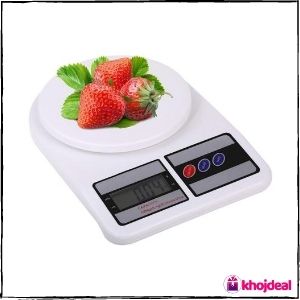
[amazon fields=”B085KW3Q9N” value=”button”]
Key Product Features & Specifications
- Compact and portable
- Easy to use
- Tare (zero) function.
- Capacity: 500g, 1000g, 3000g, 5000g
- Automatic zero resetting
- Automatic switch off in 3 seconds
- Low power, low battery and overload indicator
- Equipped with a high precision strain gauge sensor system
- Wide LCD screen display; easy to read
- Splash-proof design
- Unit exchange
- Automatic reading lock when data is stable
- Max weight: 10000g / 353oz
- Min weight: 1g / 0.0353oz
- Units: GR / OZ
- Accuracy Resolution: 1g / 0.1oz
- Material: ABS
- Dimensions (L x W x H): 24.5cm x 17cm x 3.5 cm
2. Hesley Smart Kitchen Scale
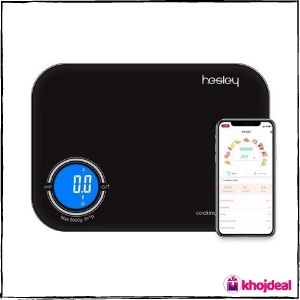
[amazon fields=”B07PZ6P49R” value=”button”]
Key Product Features & Specifications
- 3 functions: Nutrition, coffee & digital kitchen scale
- Controlled by App
- Built-in the third-generation high sensitivity platinum sensor
- Gives minimum value error
- 6 measuring units: lb, oz, fl oz, ml, g, kg
- Nutritional data of 24 food items can be auto-calculated through App
- Easy to clean
- Large LED screen display
- Weighing range: 5 to 5000 g
- Division value: 1 g
3. HealthSense KS 40 Digital Kitchen Scale
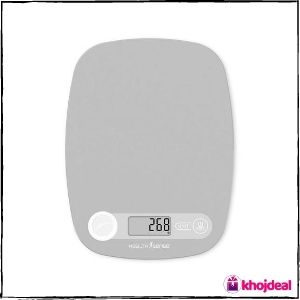
[amazon fields=”B08966L18D” value=”button”]
Key Product Features & Specifications
- Built with high precision sensors
- Measures: g, ml, lb, oz, fl oz
- Weighing range: 1g-5000g
- Unique hanging design
- Long battery life of more than 6 months when used twice a day
- Low battery & Error indicators
- Clear LCD display screen with large black fonts
- Auto-Off feature to facilitate power saving
- Two separate buttons for unit conversion
- On/Off/Tare function
- 1 Year Warranty
- Dimensions (L x W x H): 18cm x 14cm x 1.8cm
- Material: Plastic
4. MEDITIVE Digital Kitchen Scale

[amazon fields=”B01KWY9UC2″ value=”button”]
Key Product Features & Specifications
- Stainless steel weighing pan of 21.5cm x 17.5cm
- Capacity 25kg
- High accuracy of 2g
- White back light LCD display
- Runs on AAA Batteries
- Auto off function to save power
- Can run on electricity directly using an adaptor
- Measures in g, kg
- Tare function
- Piece counting function
5. ATOM A122 Digital Kitchen Scale

[amazon fields=”B00WK9OFLO” value=”button”]
Key Product Features & Specifications
- Both battery and electricity operated
- Max Capacity: 10 kg
- Min Capacity: 1kg
- Division 1 gm
- Large LCD showing 5 digits
- Conversion of g / kg / lb / oz
- Adapter is not included with the scale
- Material: Plastic
- Dimensions (L x W x H): 16.5cm x 24cm x 5.5cm
- Outside Calibration
- Auto Shut off
- 2AA Batteries included
- Low battery Indication
6. MCP Digital Kitchen Scale
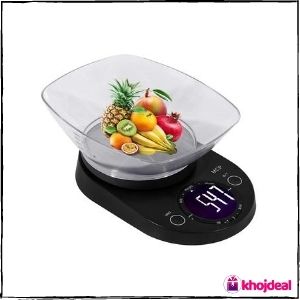
[amazon fields=”B083FY4433″ value=”button”]
Key Product Features & Specifications
- Free BPA free bowl
- Built with high precision sensors
- Measures in g, ml, lb, oz
- Weighing range: 1g-5000g
- Large blue backlit LCD display screen with black font
- Auto-off feature to facilitate power saving
- Two separate buttons for unit conversion
- On/off/tare function
- Material: Plastic
- Powered By: Battery
- Battery Type: AAA
- Number of Batteries: 3
- Low Battery Indicator: Yes
- 1 Year Warranty
- Hook to hang the scale on the wall
7. Nova Digital Weighing Scale
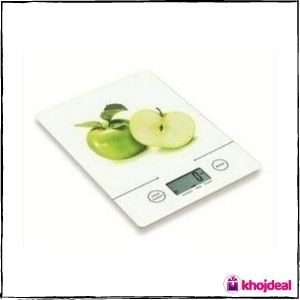
[amazon fields=”B00I5HPQIQ” value=”button”]
Key Product Features & Specifications
- High precision strain gauge sensor
- Auto zero-auto off
- Low battery / overload indication
- Multi-unit display
- Tare function
- Battery: 1. 5v x 2 AAA battery (included)
- Capacity: 5kg
- 3 different unit conversion: g, Kg, oz
- Display Size 40 mm
8. Sansui Nutrition Kitchen Scale

[amazon fields=”B07XNTZ5RP” value=”button”]
Key Product Features & Specifications
- Weighing and Kcal measurement function
- Measures 7 kinds of nutritious food choices
- Capacity: 1g to 10kg
- Division: 1g
- Touch-panel switch
- Tare function
- Auto zero resetting
- Overload/low power indication
- 4mm tempered safety glass platform
- Mini-pad style, ultra-thin appearance
- Equipped with high precision strain gauge sensor system
- Power: Four 1.5V AAA batteries (Included)
- Warranty: 1-year brand warranty from date of purchase
- Dimensions (LxWxH): 26.9cm x 18.1cm x 2cm
9. Bulfyss Digital Kitchen Scale

[amazon fields=”B00MKA9WXO” value=”button”]
Key Product Features & Specifications
- Equipped with a high precision strain gauge sensor system
- 1-year warranty
- Tare function
- Dimensions (L x W x H): 24.5cm x 17cm x 3.5cm
- Accuracy Resolution: 1g
- Measurement Range: 1g to 10000g
- Power: 1.5V X 2 AA Battery (Included)
- Splash-proof design
- Easy to use
- Made of high-quality material
- Durable enough for your daily using
- Beautiful appearance
- Special surface treatment
- Wide LCD screen display; easy to read
- Low power consumption
- Automatically lock the reading when data is stable
- Measurement units: g, oz
- Material: ABS
- Auto Power off: Yes
10. EAGLE Digital Kitchen Scale

[amazon fields=”B08CV44JCJ” value=”button”]
Key Product Features & Specifications
- Maximum weighing capacity: 10 kg
- Accuracy of 1g
- Easy to read reading even in dark areas with a green backlit display
- Equipped with a high precision strain gauge sensor system
- Splash-proof design
- Measurement units: kg, g, oz
- Power Supply: 2 x 1.5V AAA Batteries (Included)
- Material: ABS
- Dimensions (L x W x H): 24cm x 17cm x 4.1cm
- 12 months manufacturer warranty
- Free food-grade plastic pan
- Easy to use
Kitchen Scale Buying Guide: How to choosing a kitchen scale?
Kitchen scales are devices that can carry more features than you might think at first glance. If you are not used to it, it can be difficult to tell if a characteristic is a positive or a negative. Here’s what you need to know to build a good buying strategy.
1. Type Of Scale
The kitchen scale has always been a fundamental accessory in all homes, for this reason there are many different types on the market, suitable for all budgets and all needs. But how do you choose the right kitchen scale from among all the models present? The first factor to consider is related to the type of scale you want to buy. With respect to this aspect, there are two alternatives possible: the analog or mechanical kitchen scale and Digital Kitchen scale. So let’s take a closer look at how these two types differ.
📌Check Also: How To Store Cast Iron Cookware
Analog or mechanical kitchen scale – These terms mean the classic kitchen scales that measure the weight of food using a needle that moves on a numbered dial. As the name suggests, these scales have a mechanical operation. After the calibration is set manually, a series of gears inside the device allow the needle to move and indicate the weight of the food.
The upside of an analog scale is that it doesn’t require batteries to work. This certainly represents a saving for the consumer. A negative aspect of the mechanical functioning is a measurement that is not very precise and at the same time difficult to read. The analog dial may not show the exact values very clearly.
Digital kitchen scale – The digital scale models are characterized by an automatic operation, a battery power supply and a display that shows the exact weight of the weighed ingredient in numbers. They also come in varied designs which change from model to model and is closely connected to the functionality of the scale.
In these scales the calibration takes place automatically and the weight is determined thanks to the presence of sensors on the plate. Due to their automatic operation, digital kitchen scales can be equipped with several additional functions apart from measuring weight. This type of scale is the most widespread on the market, and, for this reason it is possible to find it in all price ranges.
2. Maximum Capacity
The second factor that you need to consider when choosing a kitchen scale is the maximum range of measurement, i.e. the maximum weight supported by the appliance. This aspect is very important, especially for large families who have to use a large amount of ingredients every time.
In general, a high maximum capacity is synonymous with better performance, since it allows to weigh more or less high quantities of food according to requirements. Even the minimum capacity of a scale must be taken into account. While analog models generally have a minimum capacity of 50g, it is possible to find digital models that allow you to accurately weigh quantities of less than 1g also.
These types are particularly suitable for those who want to prepare special recipes, desserts or other dishes that require very specific quantities. They can also be used to weigh spices, jewelry or other light materials that can hardly be measured on analog scales.
In general, we recommend the purchase of a scale that has a high maximum capacity and that can also measure small quantities. This will allow you to optimize your expense and have a device available to use in all circumstances.
3. Usability
The third factor to take into consideration when choosing the kitchen scale that best suits your needs is the usability offered by the appliance. By this term we mean the set of aspects that determine the possibilities of using the product, namely: accuracy, capacity and functions.
Before observing in detail each of these elements, it is necessary to underline that the best choice is represented by a scale in which these three sub-factors are equally efficient. In this way you will have maximum usability.
Accuracy – The accuracy of a kitchen scale is a very important aspect to evaluate. The term accuracy refers to the accuracy of the measurements that can be made and the degree of approximation of the values.
Many think that digital scales are more accurate than mechanical scales. However, this is not always true, since this aspect does not depend on the type of mechanism of the scale, but on the sensors which allow to detect even minimal weight variations.
Base dimensions & capacity – This aspect is also fundamental for the choice of the balance, and is closely linked to the accuracy of the measurement. On the market it is possible to find scales of all sizes, in many cases equipped with a container in which to insert the ingredients to be weighed. Although they are less bulky, small digital scales are usually not recommended.
A base that is too small means that it is not possible to measure large quantities of product. This impossibility is due to the fact that large containers cannot be placed on a small surface without compromising the stability of the balance and, if the balance is not stable, the measurement will inevitably be inaccurate.
This aspect is tied to the personal needs of the consumer. For a single person or a couple who usually need to measure small amounts of ingredients, a balance with a small base dimension can work. On the contrary, the same is not recommended for large families since large quantities of ingredients need to be measured.
Additional functions – Although it may seem superfluous, many digital scale models have additional functions that complement simple weight measurement. A multi-functional product allows you to carry out different activities with a single instrument and is, therefore, a better investment. However, the quality of the device must be observed since not all multi-functional scales are efficient and accurate in measurement. Let’s see briefly what are the most common additional functions:
- Calculation of the tare: This function will allow you to save time and at the same time have a smaller margin of error in measurements. It will, therefore, be possible to place any container on the scale plate, zero the weight and then weigh the ingredients.
- Measuring the quantities of liquids: Not everyone remembers that 1 liter equals 1 kilogram, for this reason it is easy to mistake the equivalence using traditional scales as a measuring instrument.
- Other units of measurement: In some models of kitchen scales it is also possible to set less common units of measurement such as ounces or pounds. This could be useful when you have to make international recipes where the quantities are indicated with different units of measurement.
- Battery level indicator: This is a useful function that avoids the unpleasant surprise of finding that the scale doesn’t power on when you need it.
- Automatic switch-off: This function causes the scale to switch off automatically after a preset time, for example 1 minute. It is useful to prevent the device from staying on unnecessarily and consuming battery.
- Calorie calculation: Some more sophisticated scales have a memory that contains the nutritional profiles of certain foods. In some models it is also possible to insert additional foods by saving the nutritional profiles. This function is very useful for those who have to follow a diet plan as it automatically calculates the amount of a food based on the desired calorie intake.
In some models it is also possible to find the timer function, which allows you to monitor preparations or defrosting operations and the room temperature calculation function, which is useful for obtaining better results in some recipes.
4. Design
By this term we mean all the structural characteristics of the kitchen scale. This factor is very important because the structural elements affect in a decisive manner the performance of the balance by affecting the degree of efficiency and accuracy of measurements. Let’s see in detail what are the main elements to take into consideration.
- Stability of the device: Greater stability corresponds to greater accuracy, and vice versa. To make the scales more stable and adaptable to different surfaces, many models are equipped with non-slip feet, which improves the support and ensure adherence to the worktops.
- Quantity of sensors present on the scale plate: A greater number of sensors will allow more precise and accurate results.
- Size of the display and the presence of buttons: This aspect is linked to the ease of reading the measurements and to the methods for setting the settings to navigate the scale menu. For a multi-functional scale these two elements are absolutely indispensable, as they simplify use and allow greater control over the measurements.
- Size and manageability: This element is dependent of the personal needs of the user. In general, it is possible to affirm that the scales more bulky are almost always those that allow to weigh larger quantities. The ones that are smaller and more manageable usually offer a measuring scale which ranges from 10g to 5kg.
- Ease of maintenance: For a vast majority of kitchen scales, maintenance is quick. In fact, all you need to do is wet a rag and wipe the platform. There are however some models where the weighing surface is raised, and where powder or crumbs can possibly slip.
- LCD screen: All kitchen scales have a liquid crystal display. But it’s not always designed the same. Ideally, we recommend that you opt for a machine with a fairly large, backlit screen. This is particularly true if you have vision problems.
5. Price
When choosing a kitchen scale, the price certainly represents an aspect to be taken into consideration. Given the large quantity of products available, the price can be important for orienting one’s choice.
The most expensive kitchen scales are certainly those intended for professional use: these models can cost over five thousand rupees, and are certainly the best on the market for accuracy and functionality.
For normal home use it is not necessary to spend such high amounts. It is in fact possible to find excellent products even at a medium-low cost. It all depends on the needs of the consumer. Our advice is to focus on products that belong to a price range between 500 and 800 rupees; figures neither too low nor too high, and should, therefore, correspond to products of average high quality.
6. Brand
We do not consider the brand of the kitchen scale to be a fundamental element to guide your choice. With such a wide variety of products on offer, it is easy to find excellent models produced by companies that are little known in India. Our advice is to judge the model based on factors such as the maximum and minimum capacity, the accuracy, the capacity, the design and functionality. Buying the right product for your needs without the risk of being influenced by brand is important.
7. Materials
The one question that often arises when choosing a kitchen scale is the importance of materials. With respect to this element, it is necessary to underline that most of the models on the market are made of hard plastic or metal, both fairly resistant materials that last over time. More than the materials, therefore, we believe it is important to take into consideration the overall design of the product, its stability, its size, the readability of the display and the ease of setting the various functions.
Frequently Asked Questions About Kitchen Scales (FAQs):
What is a kitchen scale?
A kitchen scale is used to measure the weight of the ingredients needed for each recipe. It is a particularly sensitive device as it is calibrated to weigh both small quantities, expressed in grams, and higher weights, up to two or more kilos, depending on the model.
What is the difference between analog and digital scale?
The analog scale is characterized by a very simple mechanism, which allows you to weigh food with manual calibration and to read the measurement on large dials.
These models do not need a battery to work and cost less than digital types. On the other hand, mechanical scales are not as accurate as electronic ones and are not ideal for showing intermediate values.
The digital models are characterized by automatic operation and equipped with buttons and a display that allows you to accurately read the weight measured. Some also allow you to measure liquids and are equipped with automatic shutdown to avoid excessive battery consumption.
Their weak point is that the battery levels need to be constantly monitored to avoid being left with a scale that discharges while you’re in the middle of meal prep.
Who should have a kitchen scale?
All those who love to cook and who dedicate themselves every day with passion and devotion to the preparation of delicious lunches and dinners, should have a kitchen scale.
It should be an essential accessory for those who intend to prepare complicated recipes that require an almost chemical precision of all the ingredients.
Similarly, those who, for health reasons or simply want to lose weight, are following a strict diet cannot fail to have one.
Finally, kitchen scales are also useful when preparing food for very young children.
Are the kitchen scales accurate?
The measurement accuracy of each scale should be indicated in its user manual. In the absence of this information, you can adopt an empirical method suggested by expert opinion. The tolerance is estimated considering about half the value of the smallest unit that is measured by that particular scale. The precision of a kitchen scale is approximately 1 gram for an electronic scale, and 5 to 10 grams for a mechanical scale.
Are mechanical scales more precise than digital ones?
No, mechanical scales do not really allow small amounts of food to be weighed with precision unlike digital scales.
What happens if you don’t tare a scale?
If you do not tare your kitchen scale, it will tell you the cumulative weight of the ingredient and the container. Do not hesitate to do a test of the tare function before embarking on a recipe.
Can we weigh things other than food with a kitchen scale?
Indeed, you can use it to weigh other objects. A kitchen scale is primarily for weighing food, but you can also use it for weighing precious metals, letters, and more.
How to calibrate a household kitchen scale?
Clean the scale to remove any debris or other objects that may affect the weight. Place it on a flat surface. Remove any other electronic equipment that may interfere with a digital scale. Set your kitchen scale to zero using the instructions for your model.
How do I reset my kitchen scale?
Remove all batteries from the back of your scale. Leave the scale without its batteries for at least 10 minutes. Then reinsert the batteries. Place your scale on a flat, even surface without a carpet. Press the center of the scale with your hand to turn it on.
Conclusion
After several hours of research and detailed examination of around thirty products available online, we consider that the HealthSense KS 40 Digital Kitchen Scale currently offers the best quality-price ratio for home use.
It can weigh up to 5 kg of ingredients, with precision to the nearest gram. It is equipped with a unique hanging design, a very readable screen, a tare function and multiple measurement units.
We do our best to offer you a comparison allowing you to choose the best possible kitchen scale. If we missed any information or new models, please feel free to leave a comment below.
Loved our blog on best kitchen scale in India? Do share it with your friends on Facebook, Twitter, and Instagram.
